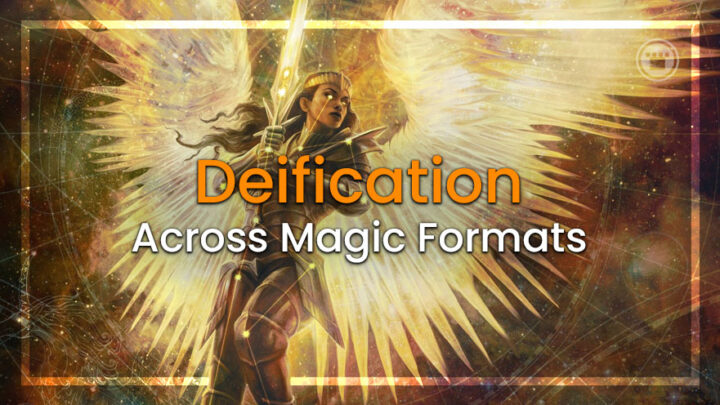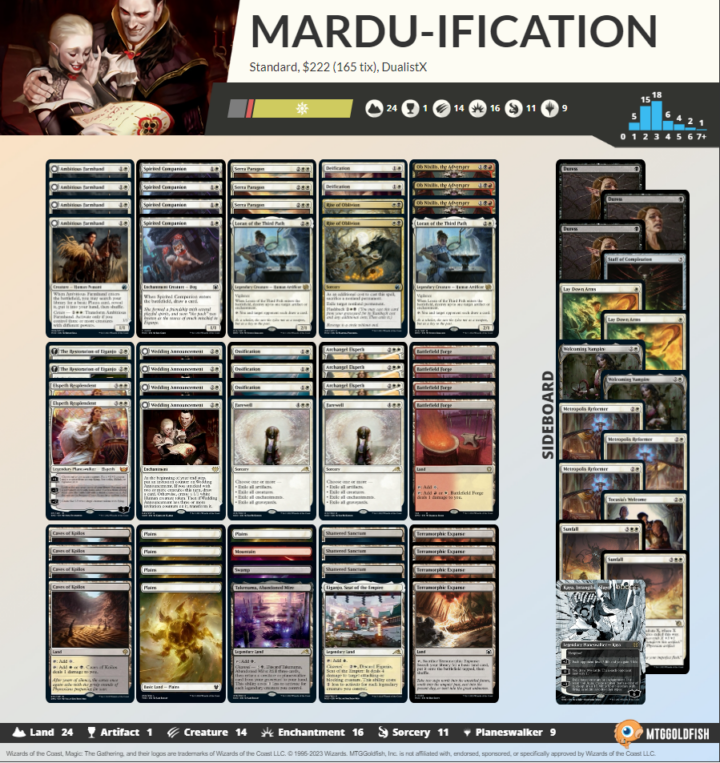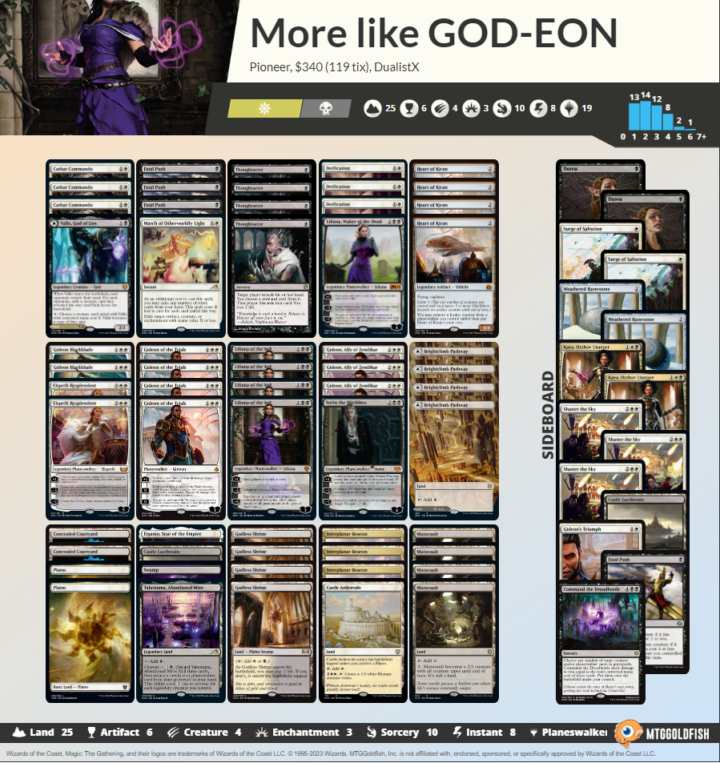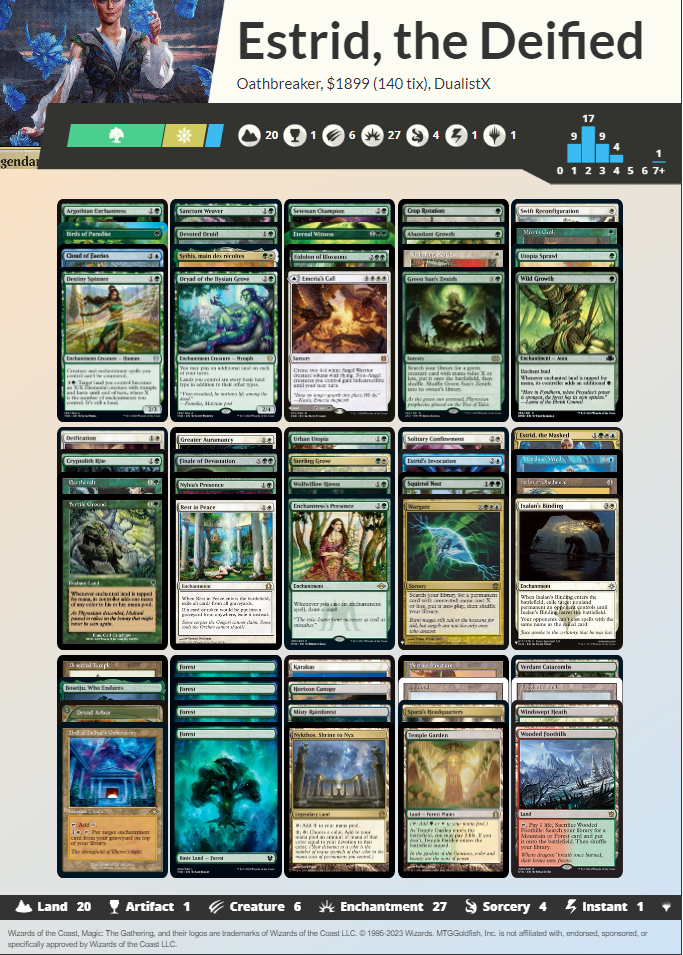Planeswalkers may have lost some potency in the multiverse of Magic, but they did receive one exciting new tool: Deification. Tom explores how this enchantment opens up lots of opportunities across formats to build novel decks.
For the most powerful mages in Magic’s Multiverse, planeswalkers sure are taking some L’s lately. First March of the Machine thinned their ranks, and now the invasion’s Aftermath has made it so the survivors aren’t as special. Now any old sod can travel between planes using permanent portals called Omenpaths.
But Aftermath also delivered us this one-card outburst of pure planeswalker love! Deification is a beautiful snapshot of the changes wrought by the MOM story arc — and it gives the biggest fans of individual planeswalkers a chance to worship at their altar.
BUILD MY TEMPLE AROUND IT
From a design perspective, Deification is something we rarely see anymore in 2023: a good old “do-nothing” enchantment.


That’s not to say it’s never good — just that the card provides essentially no effect by itself. In Deification’s case, we specifically require a Planeswalker to join it in play before we see any return on our two-mana spell.
Even then, the effect is purely defensive. So, to make Deification matter you need to be running a lot of Planeswalkers (preferably of the same type to maximize its benefits), and they need to be impactful enough to be worth protecting with other spells.
To my eyes, that all but locks us into playing a specific Planeswalker-themed strategy if we’re considering this card. Luckily, I’m already a fan of that kind of deck, and there’s quite a few formats where we can find a respectable candidate to deify.
A PANTHEON OF POSSIBILITIES
Let’s start with Standard, where our deck building choices are more obvious and the power level might be more forgiving to our unproven strategy. We might as well start by looking at which Planeswalker types would be best to name with our build-around spell.


Color is obviously a consideration, with white Planeswalkers placing less demands on the manabase. But considering how effective the multicolor lands are in current Standard, I don’t see this as a hard requirement.
There’s also an incentive to pick a Planeswalker who is represented by several different cards in the format, since we could then be protecting several different permanents with a single Deification.


But even this, I think, is a bit of a red herring for brewers. The scenario where you have multiple different Planeswalkers out plus Deification sounds like it’s already a very strong spot, so wanting the enchantment to protect both sounds a touch win-more. We’re also quite likely to be running three-plus copies of Deification, so there’s a decent chance we can have multiple in play naming different ‘walkers if we have to.
No, what I’m mainly looking for are Planeswalkers who can create creature tokens, and those with a strong uptick ability. Being able to make their own creatures lets them turn on the second clause of Deification without needing a third card in play. And having a desirable uptick means that clause is actually impactful, since we will be getting good value even if the opponent repeatedly sets them back to one loyalty.
With that in mind, I took a stab at cobbling together some of the current midrange staples around a Deification-centric core:
This is a relatively spicy list compared to the solved Standard metagame, but I’m hoping the addition of some tricky Aftermath cards can catch opponents off-guard.
The core of our deck is of course Deification, which can either protect two different Elspeths or Ob Nixilis. Archangel Elspeth is just a solid token producer, but Elspeth Resplendent has some specific upside by finding her own Deification (or supporting creature) out of our deck.


Ob Nixilis may force us to stretch our colors, but he’s probably the single best card to combine with Deification in Standard. He’s cheap, he has a valuable uptick ability, he makes his own creature tokens and his casualty clause creates some uniquely good synergy.
With Deification out, we can cast Ob Nixilis sacrificing a one-power creature, create a devil with the main copy, and uptick the token. If the opponent can’t immediately remove the Devil (and any other creatures in play) AND attack our hexproof Nixilis twins, then they’re doomed to a huge ongoing resource drain as we heedlessly uptick both copies every turn.
We no longer have to worry about combating Invoke Despair, a recently banned spell which could take out both Deification and the Planeswalker behind it. Still, some of our extra enchantments, like Wedding Announcement, can still buy us valuable time to set up our game plan. And for the decks playing cards like Sheoldred’s Edict, we have three Metropolis Reformer coming in from the sideboard.
Oh, and if you’re wondering why I didn’t go with The Wandering Emperor for this build, her trademark anonymity prevents us from naming her with Deification. Oops.

DEAD MAN (PLANES)WALKING
Onto Pioneer, and a deck I originally debuted on this blog back when both that format and my tenure here were new: Orzhov Gideons.


Gideon of the Trials has definitely lost some of his luster over time as the format gained exponentially better answers for him, but he is still one of the only other cards that actively rewards playing a bunch of the same Planeswalker type. And the ability of your Gideon squad to become creatures and beat face makes for a simple and reliable win-con once we’ve established a “lock” behind Deification.
The big appeal of this deck was always its flexibility, being able to pivot between aggression and control extremely well in ways that opponents often find difficult to predict. While this updated build contains slightly fewer cards capable of direct damage-dealing, the hand attack angle we gain from our Lilianas more than makes up for it. The double-sided discard lets us get value from any unwanted duplicate copies of our various legends (or Deification).


The older build of the deck could sometimes checkmate Aggro players with a combination of Gideon of the Trials emblem plus Oath of Kaya, but Deification is a much more reliable win condition should your opponent lack enchantment removal.
It’s often worth creating the Gideon of the Trials emblem early in the game if he’s not immediately threatened, as it creates the chance to stumble into emblem + Deification + random Gideon later on.


Mutavault and Heart of Kiran help us keep opposing sorcery-speed removal blank (and play around our own sweepers), but they are also integral to the performance of Deification in this list. By animating them with damaging effects on the stack (or after blockers are declared) we can make sure we control a creature whenever Deification’s second clause is about to trigger and save our life-sustaining Planeswalkers.
The sideboard should be taken with a mountain of salt. This is a reactive kind of deck list, and you should always be updating these slots with answers to the decks currently giving you trouble. One exception is Command the Dreadhorde, which can always be abused with a Gideon emblem should you need more inevitability for midrange matchups.
OATH OF THE MASKED GOD
You can’t write about such a planeswalker-centric strategy as this in 2023 without discussing Oathbreaker, or so I’ve been told. (As in, our lead writer literally told me I needed to cover Magic’s newest official format as a precondition for approving this article.)
Lucky for me, I already had the perfect Oathbreaker in mind to deify.
When I wrote a few months back about Planeswalkers who might “find a home” in the Oathbreaker format, Estrid could easily have been among my examples. Having debuted in a Commander precon, she has never been Constructed-legal outside of Legacy and Vintage — formats where aura-centric strategies rarely flourish and aren’t looking for help from a three-color four-drop in any case.


She’s obviously designed for Commander, but she’s a bit underwhelming even there. Four mana is just sort of high on the curve to be casting what is essentially a mana accelerant, and a conditional one at that.
But in the world of Oathbreaker? Estrid fits in like a Swift Reconfiguration fits on a Devoted Druid.
Serra’s Sanctum is the best possible payoff for Estrid’s untapping uptick, and by choosing Wargate as our signature spell we essentially have that land in the Command Zone every game. The huge influx of mana generated by that pairing then allows us to cast Wargate over and over again, tutoring out silver-bullet answers or more probably, one of many two-card infinite combos to win.


Subscribing to the belief that proactive gameplay is king in multiplayer formats, I’ve packed in every card-efficient enchantment-based combo I could think of: Devoted Druid and Swift Reconfiguration; Rest in Peace and Helm of Obedience; Earthcraft and Squirrel Nest; even Cloud of Faeries and Words of Wind.


It’s not uncommon to stumble into one of these combos “naturally” on turn three. If not, you should be able to build toward multiple possible wins via both Wargate spam and Enchantress draw triggers.
There are also spells like Finale of Devastation and Destiny Spinner, which aren’t technically infinites but can net easy lethals off our true win condition: disgusting amounts of Estrid-enabled mana.
This is what makes Deification such a natural addition to the deck. Estrid’s uptick is all we need or want to use in 90% of games, and by making her hexproof and damage-proof, we essentially make our main engine immune to interaction. Even with three opponents arrayed against us, the sheer rate at which Estrid presents combo threats will be tough to keep up with after that.
A BEATIFIC BREWING EXPERIENCE
Deification is hardly the most exciting card in March of the Machine: Aftermath from a competitive standpoint. There’s a reason that Wizards of the Coast has largely moved away from designing such “do-nothing” enchantments, even if they promise guaranteed value on future turns. Deification doesn’t guarantee anything at all!

But it does offer the slightly more casual brewer something very valuable: a unique angle on deck building that opens up previously unseen synergies. I’m genuinely excited to see if I can curve out Deification into Ob Nixilis, the Adversary — even if it only happens once every couple of games.
Plus, you never really know when a fringe strategy like this one might suddenly burst into the limelight. As Door to Nothingness recently reminded us by posting results in Modern, even the most obscure rares are just one synergistic new printing away from mainstream relevance.
Deification’s day in the sun may not be here yet, but I’ll bet you it’s coming.

Tom’s fate was sealed in 7th grade when his friend lent him a pile of commons to play Magic. He quickly picked up Boros and Orzhov decks in Ravnica block and has remained a staunch white magician ever since. A fan of all Constructed formats, he enjoys studying the history of the tournament meta. He specializes in midrange decks, especially Death & Taxes and Martyr Proc. One day, he swears he will win an MCQ with Evershrike. Ask him how at @AWanderingBard, or watch him stream Magic at twitch.tv/TheWanderingBard.







